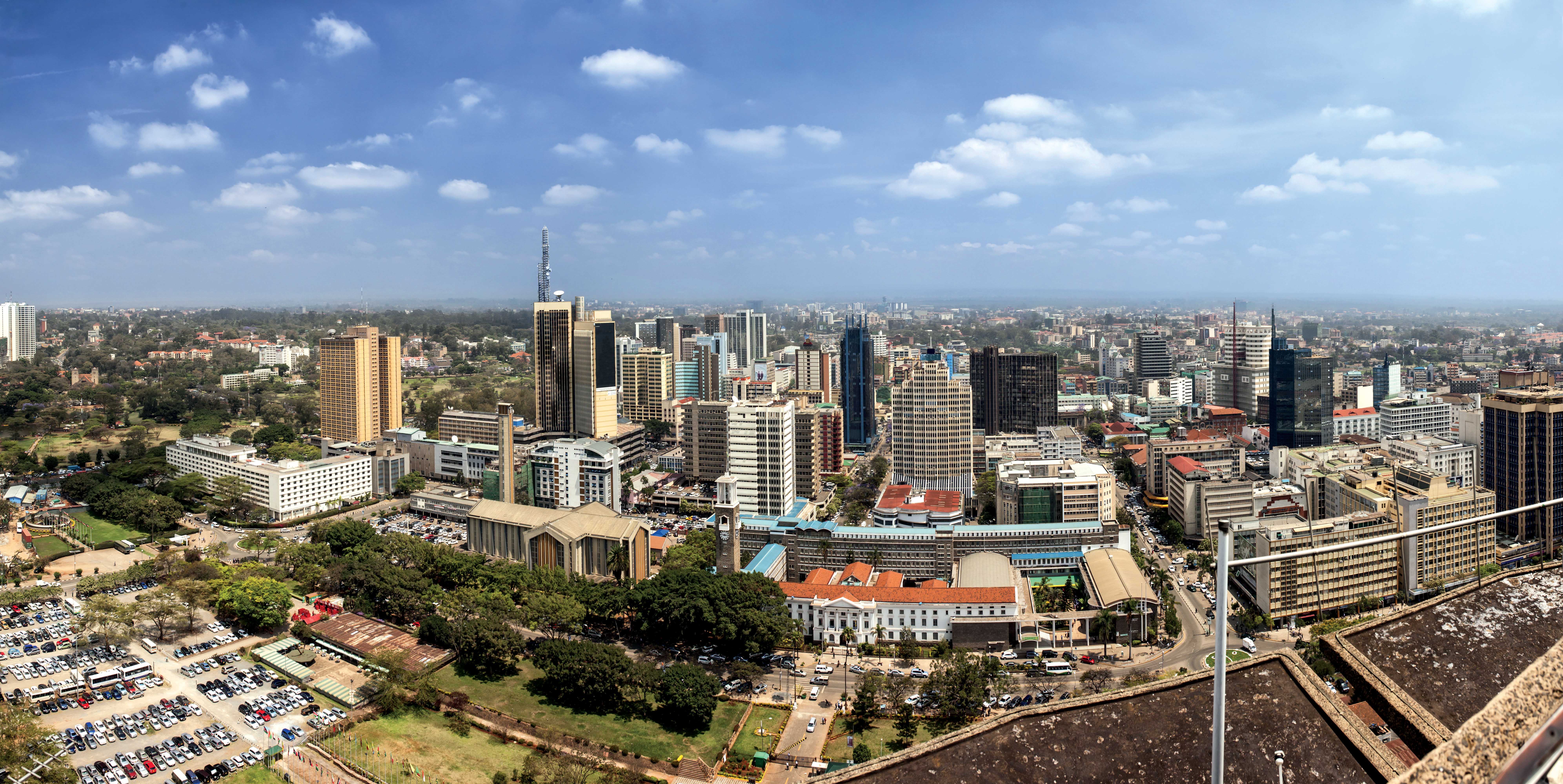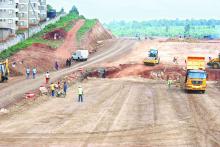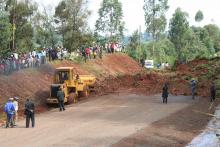Kenya is introducing novel methods for funding its necessary road infrastructure development - Shem Oirere writes. Kenya has unveiled a new financing model for road construction and reviewed its design standards and construction methodologies, which forms part of a new strategy for the East African country. Under this new plan Kenya is planning to upgrade 10,000km of road, with these links featuring asphalt surfacing; the work being carried out over the next five years at a cost of US$2.8 billion. Despite t

In urban areas, the Annuity programme is expected to reduce traffic congestion and pollution, particularly in capital Nairobi
Kenya is introducing novel methods for funding its necessary road infrastructure development - Shem Oirere writes
Kenya has unveiled a new financing model for road construction and reviewed its design standards and construction methodologies, which forms part of a new strategy for the East African country. Under this new plan Kenya is planning to upgrade 10,000km of road, with these links featuring asphalt surfacing; the work being carried out over the next five years at a cost of US$2.8 billion. Despite the country grappling with a backlog of road maintenance works requiring $4.3 billion, the Kenyan Government has moved ahead with the new plan, commonly called the Annuity financing programme. This will nearly double the number of Kenya’s asphalt surfaced roads from the current 14,000km, an equivalent of 8.8% of the 161,451km of classified roads, to 24,000km by the end of 2017.
“Under this Annuity programme, we will complete 2,000km of small roads within 2014/2015 financial year. This will be followed by 3,000km in 2015/2016, made up of 80% small roads, and 20% highways. In (the) 2016/2017 financial year, we will complete 5,000km, 80% of which will be small roads and 20% highways,” said president Uhuru Kenyatta when he launched the ambitious road project in the capital, Nairobi.
The president said that Kenya has taken 50 years to surface the 14,000km of road, or an estimated 242km/year, because of low investment in the road sector, corruption in government, lethargy among State officers and insistence on outdated national development models.
The government hopes the project will enable Kenya to transform itself into a low-cost investment and trading destination. This will also support the projected economic growth, which is expected to expand by 6.9% this year, up from an initial growth forecast of 6.5% according to a policy statement by Treasury in January.
The new 10,000km of asphalt surfaced roads will promote national integration and improve security because of connectivity of regions and communities according to the2639 Kenya National Highways Authority (KeNHA), a State-owned operator of national trunk roads.
In urban areas, the Annuity programme is expected to reduce traffic congestion and pollution, particularly in capital Nairobi where the government estimates that traffic jams cost $578,000/day in lost productivity. The new plan will create more arteries into and out of the cities and towns and reduce commute times.
To achieve the road plan objectives within the stipulated time and also deliver quality work, KeNHA is proposing a major shift from the conventional road development financing models and conservative road designs. According to KeNHA these have been a major constraint in the country’s development for 50 years.
KeNHA director general Meshack Kidenda said that the lack of innovative financing models and the insistence on using traditional construction techniques has locked up private investments that could have catalysed road sector growth. He said the Annuity programme and conventional public-private partnerships are some of the models that could translate the 10,000km road pavement plan into a successful case.
Under the Annuity programme, contractors are being encouraged to design, finance, construct and maintain roads based on agreed periodical payments by the government. The payments are extended after the construction of the project, which Kidenda says is the best option for roads which are not viable for the conformist tolling public-private partnerships. He said innovative public-private partnerships allow the private sector, “…to finance, design, construct, maintain and operate the road and recover initial investment through toll proceeds.”
The Kenya Private Sector Alliance (KEPSA), which includes road contractors and engineers in its rank of members, says the Annuity financing model has been tried in road construction in other countries with success.
“Kenya has chosen to implement the model close to the one adopted in India. This model‘s effectiveness and success in India erases all doubts to its workability in Kenya,” explained Johnson Matu, chairman of the infrastructure committee at KEPSA.
“This framework involves the formation of special purpose vehicles or consortiums consisting of consulting engineers, contractors, financiers, and project managers (to implement road projects),” he said.
Despite 90% of Kenya’s cargo and passenger traffic relying on road transport, the sector has heavily depended upon financing from the direct exchequer and proceeds from the Roads Maintenance Levy Fund (RMLF). The latter is a tax on fuel charged at $0.03/litre. This funding stream is used to build new roads and maintain existing links. The road sector requires $44 million/year for the next 10 years to meet its targets for maintenance and new road development.
During the 2014/15 financial year for example, Infrastructure and Transport Ministry Principal Secretary John Mosonik says only $273 million was available for the annual public roads programme, which is implemented by KeNHA, Kenya Rural Roads Authority,6679 Kenya Urban Roads Authority and Kenya Wildlife Service. This year, the ministry had planned to carry out maintenance work on 52,911km of the road network, equivalent of 33% of the country’s classified road network at a cost of $446 million.
The $273 million, Mosonik says, is what is collected from RMLF ($271 million) and transit tolls ($5,070 million) by the Kenya Roads Board, an equivalent of 50% of what is required annually for road maintenance, rehabilitation and development of new ones.
Because of the huge funding gap, the Transport Ministry says it owes contractors $273 million for projects that had yet to be completed by end of 2013 and those which had been certified as complete. Private road constructors are also owed $967 million for projects slated for completion in 2016 including projects that are yet to be billed.
“The government has in 2014/2015 financial year allocated $449 million to meet part of the ongoing commitments and pending bills but we still need $515 million over the next two financial years to complete the ongoing contracts,” said Kidenda.
“The situation calls for alternative financing and delivery methodologies to achieve set targets of 10,000km of new paved roads,” he said.
The Annuity plan has been introduced to help the road sector surmount this financing constraint.
According to Matu, under the Annuity financing model, “…the consultants and contractors will design and construct the roads while financing is done by bankers with guarantees from the government. The model will increase business between commercial banks, contractors and the government. Insurance companies will insure the works while performance guarantees will be provided by the banks as usual.”
“The contractor has the advantage and assurance that the payment for work done will come in time. This will be based on the progress of the work, unlike the previous experiences that ended up with many contractors on the losing end after work.”
And 49 international and local contractors have already been shortlisted for the first phase of the Annuity programme, which involves construction of 3,008.87km of rural roads by the end of June this year, in 45 lots, according to Mosonik. The 3,008.87km is a revised figure from the 2,000km that were approved in June last year, in 29 lots.
The successful bidders will, however, be required to raise at least 70% of the total cost of a project before they are awarded the contract.
Among the shortlisted contactors are 10 Chinese firms, which include China Wu Yi, which has undertaken some of the largest infrastructure projects in Kenya. Other prequalified firms include H Young Limited, SBI International Holdings AG, SS Mehta and Sons Limited, Hayer Bishan Singh and Put Sarajevo General Engineering Company.
The prequalification elicited mixed reactions from Kenyan contractors through the Kenya Federation of Master Builders, which claimed that the Chinese firms have been given more than their fair share of the Annuity project.
At least 26 firms under the Federation formed a consortium, Master Builders Sacco, to bid for a share of the road programme but were disqualified.
“We will lobby top government officials, including the president and parliamentarians, to be given the opportunity to construct some of the roads,” said Federation chairman Moses Muhia.
But the government defended itself against accusations of bias in the prequalification, and commented, “…the consortia failed to demonstrate participation by any consortium member in any contract with a value of $5.6 million over the past five years.”
Federation secretary Thiaka Muchai, was quoted as saying, “The condition was put there to specifically disqualify local contractors.”
“We had gone round it by getting a letter from a leading local bank indicating it would finance the works if we won the tenders.”
However, Matu, who is also a member of the Association of Consulting Engineers of Kenya, said that the new model of road construction brings new challenges to road contractors.
“The preparedness of the private sector to take advantage of the opportunity presented in this innovative and attractive business model is in question,” he commented.
“The private sector has been dependent on the government spending and must now take more risks associated with the construction of roads and their maintenance and includes the quality of the works as well.”
He said, “It is imperative to the contractors and consultants to adopt innovative technologies that save costs and keep roads in good condition for longer periods against unpredictable traffic patterns.”
Unlike in the past, the government will, under the Annuity scheme, pay for road projects completed under Annuity concessions where the contractor is paid through a fixed, periodical payment instead of relying on toll proceeds.
“The contractors will borrow money from commercial banks and other financial institutions and undertake projects with expectation of payment by government over a period of 8-10 years,” said Infrastructure and Transport Cabinet secretary Michael Kamau.
The plan to pay contractors for roads built and certified as complete will also help eliminate poor workmanship. And president Uhuru commented, “Weak contractual arrangements provided a perfect opportunity for briefcase buccaneers and cowboy racketeers to masquerade as contractors while fleecing the taxpayers.”
The 8,000km of small roads will cost $1.75 billion while the 2,000km of highway will cost $1.09 billion with Kamau saying banks could earn as much as $996 million interest from lending to contractors during the five years.
To cushion contractors from punitive measures for delayed payments, the government is negotiating with banks to extend the lending period from the current maximum seven years to at least 15-20 years to address the mismatch, according to KeNHA general manager Samwel Omer.
Apart from the roping in of commercial banks to raise road sector financing, the Kenya Roads Board is also proposing new strategies to mobilise cash to support new projects and maintain existing road network.
“In order to increase the road network under maintenance, the Infrastructure and Transport Ministry is exploring other ways of raising financing including infrastructure bond, outdoor advertising, public-private partnerships and now the Annuity financing model,” said Mosonik.
Kenya Roads Board executive director Jacob Ruwa said other additional funding sources the agency is targeting include vehicle inspection fees, insurance levy and an increase of the RMLF by $0.03/litre.
The board is also pursuing proposals meant to enhance the efficiency of road management in Kenya including the introduction of performance-based contracting as well as the use of simpler surfacing methods for paving low volume roads.
According to Ruwa, public-private partnerships can be turned into more innovative schemes by introducing road concessioning, promoting build-operate-transfer models and also the fund-rehabilitate-maintain-transfer scheme.
In the last quarter of 2014, the Kenyan Government raised a 12-year infrastructure bond worth $168 million at a fixed interest rate of 11% to finance the road network expansion, as well as provide funding for other projects. The bond, which was oversubscribed by 158.8%, came shortly after Kenya’s $2 billion 5-year debut Eurobond in June which raised Sh251.5 billion in 2014.
Although the government has said the $168 million 12-year bond is an infrastructure one, Netherlands-based think-tank, the European Centre for Development Policy, says what Kenya and other African countries such Cameroon, Chad have raised, “…are not strictly infrastructure bonds.”
“They are general government bonds with some promise to spend the money in infrastructure investment and have no income stream associated with the underlying asset, and cash flows for the bonds are paid directly out of government tax revenues,” it explained.
“ There is also no guarantee that the money raised goes into the project as promised, and neither is there a dedicated Fund Manager, raising concerns about the ability of central government to channel the funds to actual development of infrastructure projects.”
The road sector financing challenges and finance mobilisation initiatives come at a time when Kenya has turned its back on the decades-old Cumulative Equivalent Standard Axles (CESA) of 1,000,000 as the minimum road pavement design standard. Many Kenya rural roads carry much less traffic.
“The effect has been that roads were overdesigned and construction costs were correspondingly high,” said Kidenda.
For the new 10,000km of paved roads planned under the Annuity financing programme, KeNHA has adopted a new standard for the low volume roads (Traffic Class T5), which represent 80% of the targeted roads.
The roads have been classified further into five sub-categories ranging from T5-0 to T5-4 with different Cumulative Equivalent Standard Axles. For the T5-0 category the CESA will be
500, 0000 to 1,000,000 while T5-1 it will be 250,000 to 500,000, T5-2 will be 100,000 to 250,000, T5-3 is now set at 25,000 to 100,000 and finally T5-4 will be less than 25,000.
According to Kidenda, this new design for low volume roads will contribute to cutting the unit costs in road construction and maintenance/km.
Looking ahead, this new approach means that Kenya’s inhabitants stand to benefit greatly from a much improved road network that will reduce journey times as well as congestion in urban areas.
Kenya has unveiled a new financing model for road construction and reviewed its design standards and construction methodologies, which forms part of a new strategy for the East African country. Under this new plan Kenya is planning to upgrade 10,000km of road, with these links featuring asphalt surfacing; the work being carried out over the next five years at a cost of US$2.8 billion. Despite the country grappling with a backlog of road maintenance works requiring $4.3 billion, the Kenyan Government has moved ahead with the new plan, commonly called the Annuity financing programme. This will nearly double the number of Kenya’s asphalt surfaced roads from the current 14,000km, an equivalent of 8.8% of the 161,451km of classified roads, to 24,000km by the end of 2017.
“Under this Annuity programme, we will complete 2,000km of small roads within 2014/2015 financial year. This will be followed by 3,000km in 2015/2016, made up of 80% small roads, and 20% highways. In (the) 2016/2017 financial year, we will complete 5,000km, 80% of which will be small roads and 20% highways,” said president Uhuru Kenyatta when he launched the ambitious road project in the capital, Nairobi.
The president said that Kenya has taken 50 years to surface the 14,000km of road, or an estimated 242km/year, because of low investment in the road sector, corruption in government, lethargy among State officers and insistence on outdated national development models.
The government hopes the project will enable Kenya to transform itself into a low-cost investment and trading destination. This will also support the projected economic growth, which is expected to expand by 6.9% this year, up from an initial growth forecast of 6.5% according to a policy statement by Treasury in January.
The new 10,000km of asphalt surfaced roads will promote national integration and improve security because of connectivity of regions and communities according to the
In urban areas, the Annuity programme is expected to reduce traffic congestion and pollution, particularly in capital Nairobi where the government estimates that traffic jams cost $578,000/day in lost productivity. The new plan will create more arteries into and out of the cities and towns and reduce commute times.
To achieve the road plan objectives within the stipulated time and also deliver quality work, KeNHA is proposing a major shift from the conventional road development financing models and conservative road designs. According to KeNHA these have been a major constraint in the country’s development for 50 years.
KeNHA director general Meshack Kidenda said that the lack of innovative financing models and the insistence on using traditional construction techniques has locked up private investments that could have catalysed road sector growth. He said the Annuity programme and conventional public-private partnerships are some of the models that could translate the 10,000km road pavement plan into a successful case.
Under the Annuity programme, contractors are being encouraged to design, finance, construct and maintain roads based on agreed periodical payments by the government. The payments are extended after the construction of the project, which Kidenda says is the best option for roads which are not viable for the conformist tolling public-private partnerships. He said innovative public-private partnerships allow the private sector, “…to finance, design, construct, maintain and operate the road and recover initial investment through toll proceeds.”
The Kenya Private Sector Alliance (KEPSA), which includes road contractors and engineers in its rank of members, says the Annuity financing model has been tried in road construction in other countries with success.
“Kenya has chosen to implement the model close to the one adopted in India. This model‘s effectiveness and success in India erases all doubts to its workability in Kenya,” explained Johnson Matu, chairman of the infrastructure committee at KEPSA.
“This framework involves the formation of special purpose vehicles or consortiums consisting of consulting engineers, contractors, financiers, and project managers (to implement road projects),” he said.
Despite 90% of Kenya’s cargo and passenger traffic relying on road transport, the sector has heavily depended upon financing from the direct exchequer and proceeds from the Roads Maintenance Levy Fund (RMLF). The latter is a tax on fuel charged at $0.03/litre. This funding stream is used to build new roads and maintain existing links. The road sector requires $44 million/year for the next 10 years to meet its targets for maintenance and new road development.
During the 2014/15 financial year for example, Infrastructure and Transport Ministry Principal Secretary John Mosonik says only $273 million was available for the annual public roads programme, which is implemented by KeNHA, Kenya Rural Roads Authority,
The $273 million, Mosonik says, is what is collected from RMLF ($271 million) and transit tolls ($5,070 million) by the Kenya Roads Board, an equivalent of 50% of what is required annually for road maintenance, rehabilitation and development of new ones.
Because of the huge funding gap, the Transport Ministry says it owes contractors $273 million for projects that had yet to be completed by end of 2013 and those which had been certified as complete. Private road constructors are also owed $967 million for projects slated for completion in 2016 including projects that are yet to be billed.
“The government has in 2014/2015 financial year allocated $449 million to meet part of the ongoing commitments and pending bills but we still need $515 million over the next two financial years to complete the ongoing contracts,” said Kidenda.
“The situation calls for alternative financing and delivery methodologies to achieve set targets of 10,000km of new paved roads,” he said.
The Annuity plan has been introduced to help the road sector surmount this financing constraint.
According to Matu, under the Annuity financing model, “…the consultants and contractors will design and construct the roads while financing is done by bankers with guarantees from the government. The model will increase business between commercial banks, contractors and the government. Insurance companies will insure the works while performance guarantees will be provided by the banks as usual.”
“The contractor has the advantage and assurance that the payment for work done will come in time. This will be based on the progress of the work, unlike the previous experiences that ended up with many contractors on the losing end after work.”
And 49 international and local contractors have already been shortlisted for the first phase of the Annuity programme, which involves construction of 3,008.87km of rural roads by the end of June this year, in 45 lots, according to Mosonik. The 3,008.87km is a revised figure from the 2,000km that were approved in June last year, in 29 lots.
The successful bidders will, however, be required to raise at least 70% of the total cost of a project before they are awarded the contract.
Among the shortlisted contactors are 10 Chinese firms, which include China Wu Yi, which has undertaken some of the largest infrastructure projects in Kenya. Other prequalified firms include H Young Limited, SBI International Holdings AG, SS Mehta and Sons Limited, Hayer Bishan Singh and Put Sarajevo General Engineering Company.
The prequalification elicited mixed reactions from Kenyan contractors through the Kenya Federation of Master Builders, which claimed that the Chinese firms have been given more than their fair share of the Annuity project.
At least 26 firms under the Federation formed a consortium, Master Builders Sacco, to bid for a share of the road programme but were disqualified.
“We will lobby top government officials, including the president and parliamentarians, to be given the opportunity to construct some of the roads,” said Federation chairman Moses Muhia.
But the government defended itself against accusations of bias in the prequalification, and commented, “…the consortia failed to demonstrate participation by any consortium member in any contract with a value of $5.6 million over the past five years.”
Federation secretary Thiaka Muchai, was quoted as saying, “The condition was put there to specifically disqualify local contractors.”
“We had gone round it by getting a letter from a leading local bank indicating it would finance the works if we won the tenders.”
However, Matu, who is also a member of the Association of Consulting Engineers of Kenya, said that the new model of road construction brings new challenges to road contractors.
“The preparedness of the private sector to take advantage of the opportunity presented in this innovative and attractive business model is in question,” he commented.
“The private sector has been dependent on the government spending and must now take more risks associated with the construction of roads and their maintenance and includes the quality of the works as well.”
He said, “It is imperative to the contractors and consultants to adopt innovative technologies that save costs and keep roads in good condition for longer periods against unpredictable traffic patterns.”
Unlike in the past, the government will, under the Annuity scheme, pay for road projects completed under Annuity concessions where the contractor is paid through a fixed, periodical payment instead of relying on toll proceeds.
“The contractors will borrow money from commercial banks and other financial institutions and undertake projects with expectation of payment by government over a period of 8-10 years,” said Infrastructure and Transport Cabinet secretary Michael Kamau.
The plan to pay contractors for roads built and certified as complete will also help eliminate poor workmanship. And president Uhuru commented, “Weak contractual arrangements provided a perfect opportunity for briefcase buccaneers and cowboy racketeers to masquerade as contractors while fleecing the taxpayers.”
The 8,000km of small roads will cost $1.75 billion while the 2,000km of highway will cost $1.09 billion with Kamau saying banks could earn as much as $996 million interest from lending to contractors during the five years.
To cushion contractors from punitive measures for delayed payments, the government is negotiating with banks to extend the lending period from the current maximum seven years to at least 15-20 years to address the mismatch, according to KeNHA general manager Samwel Omer.
Apart from the roping in of commercial banks to raise road sector financing, the Kenya Roads Board is also proposing new strategies to mobilise cash to support new projects and maintain existing road network.
“In order to increase the road network under maintenance, the Infrastructure and Transport Ministry is exploring other ways of raising financing including infrastructure bond, outdoor advertising, public-private partnerships and now the Annuity financing model,” said Mosonik.
Kenya Roads Board executive director Jacob Ruwa said other additional funding sources the agency is targeting include vehicle inspection fees, insurance levy and an increase of the RMLF by $0.03/litre.
The board is also pursuing proposals meant to enhance the efficiency of road management in Kenya including the introduction of performance-based contracting as well as the use of simpler surfacing methods for paving low volume roads.
According to Ruwa, public-private partnerships can be turned into more innovative schemes by introducing road concessioning, promoting build-operate-transfer models and also the fund-rehabilitate-maintain-transfer scheme.
In the last quarter of 2014, the Kenyan Government raised a 12-year infrastructure bond worth $168 million at a fixed interest rate of 11% to finance the road network expansion, as well as provide funding for other projects. The bond, which was oversubscribed by 158.8%, came shortly after Kenya’s $2 billion 5-year debut Eurobond in June which raised Sh251.5 billion in 2014.
Although the government has said the $168 million 12-year bond is an infrastructure one, Netherlands-based think-tank, the European Centre for Development Policy, says what Kenya and other African countries such Cameroon, Chad have raised, “…are not strictly infrastructure bonds.”
“They are general government bonds with some promise to spend the money in infrastructure investment and have no income stream associated with the underlying asset, and cash flows for the bonds are paid directly out of government tax revenues,” it explained.
“ There is also no guarantee that the money raised goes into the project as promised, and neither is there a dedicated Fund Manager, raising concerns about the ability of central government to channel the funds to actual development of infrastructure projects.”
The road sector financing challenges and finance mobilisation initiatives come at a time when Kenya has turned its back on the decades-old Cumulative Equivalent Standard Axles (CESA) of 1,000,000 as the minimum road pavement design standard. Many Kenya rural roads carry much less traffic.
“The effect has been that roads were overdesigned and construction costs were correspondingly high,” said Kidenda.
For the new 10,000km of paved roads planned under the Annuity financing programme, KeNHA has adopted a new standard for the low volume roads (Traffic Class T5), which represent 80% of the targeted roads.
The roads have been classified further into five sub-categories ranging from T5-0 to T5-4 with different Cumulative Equivalent Standard Axles. For the T5-0 category the CESA will be
500, 0000 to 1,000,000 while T5-1 it will be 250,000 to 500,000, T5-2 will be 100,000 to 250,000, T5-3 is now set at 25,000 to 100,000 and finally T5-4 will be less than 25,000.
According to Kidenda, this new design for low volume roads will contribute to cutting the unit costs in road construction and maintenance/km.
Looking ahead, this new approach means that Kenya’s inhabitants stand to benefit greatly from a much improved road network that will reduce journey times as well as congestion in urban areas.









